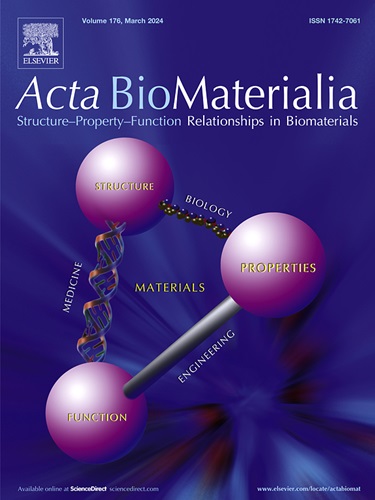In-situ oxygen-supplying ROS nanopurifier for enhanced healing of MRSA-infected diabetic wounds via microenvironment modulation
IF 9.4
1区 医学
Q1 ENGINEERING, BIOMEDICAL
引用次数: 0
Abstract
Hypoxia, high ROS levels and chronic inflammation are the main factors that hinder the healing of diabetic wounds. Long-term exposed wounds are prone to bacterial infection, especially MRSA infection, which exacerbates the complex wound microenvironment of diabetes and threatens patients’ lives. Here, we developed a ROS nanopurifier (CSVNP), which was prepared by loading superoxide dismutase (SOD), catalase (CAT) and vancomycin into nanogels through in-situ polymerization. CSVNP can effectively increase enzyme loading and stability, and improve cascade reaction efficiency between enzymes through nanosize effect, so that CSVNP can use a variety of ROS (H2O2 and ·O2-) as oxygen sources to generate much oxygen in situ, which can effectively alleviate the hypoxic environment and inflammatory response of diabetic tissues, theraby promoting cell migration and angiogenesis, and accelerating wound healing. In addition, the generated oxygen can further promote the transformation of pro-inflammatory M1 macrophages into anti-inflammatory M2 macrophages and reduce pro-inflammatory factors (TNF-α, IL-6, and IL-1β) release. CSVNP can also effectively eradicate MRSA by releasing vancomycin, preventing bacterial infection from exacerbating the deterioration of diabetic wounds. This multifunctional ROS nanopurifier with antiphlogosis, antibacterial and in-situ oxygen supply, provides a new strategy with universal and translational prospects for clinical diabetic tissue damage.
Statement of Significance
Methicillin-resistant staphylococcus aureus (MRSA)-infected diabetic wounds face significant challenges in clinical care, characterized by high ROS levels, acute inflammation, vascular lesions, and hypoxia, which impede healing and risk severe complications. Here, we originally developed a reactive oxygen species (ROS) nanopurifier prepared by in-situ polymerization of superoxide dismutase (SOD), catalase (CAT), and vancomycin. It uses SOD and CAT to continuously convert ROS (H2O2 and ·O2-) into O2 in diabetic tissues, effectively improving hypoxia and chronic inflammation, thereby promoting angiogenesis and cell proliferation and migration, and accelerating diabetic wound healing. Vancomycin can effectively kill MRSA bacteria, avoid bacterial infection spread, and reduce complications risk. This safe, efficient and easy-to-prepare ROS nanopurifier provides a general strategy for repairing MRSA-infected diabetic tissue damage.

原位供氧ROS纳米净化器通过微环境调节促进mrsa感染的糖尿病伤口愈合。
缺氧、高ROS水平和慢性炎症是阻碍糖尿病创面愈合的主要因素。长期暴露的创面容易发生细菌感染,尤其是MRSA感染,加剧了糖尿病复杂的创面微环境,威胁患者生命。本课题通过原位聚合将超氧化物歧化酶(SOD)、过氧化氢酶(CAT)和万古霉素负载到纳米凝胶中,制备了一种ROS纳米净化器(CSVNP)。CSVNP可以通过纳米效应有效增加酶的负荷和稳定性,提高酶之间的级联反应效率,使CSVNP可以利用多种活性氧(H2O2和·O2-)作为氧源,在原位产生大量氧气,从而有效缓解糖尿病组织的缺氧环境和炎症反应,促进细胞迁移和血管生成,促进创面愈合。此外,产生的氧气可进一步促进促炎M1巨噬细胞向抗炎M2巨噬细胞转化,减少促炎因子(TNF-α、IL-6、IL-1β)的释放。CSVNP还能通过释放万古霉素有效根除MRSA,防止细菌感染加重糖尿病创面恶化。这种具有抗炎、抗菌和原位供氧功能的多功能活性氧纳米净化器,为临床糖尿病组织损伤提供了一种具有普遍应用和转化前景的新策略。意义声明:耐甲氧西林金黄色葡萄球菌(MRSA)感染的糖尿病伤口在临床护理中面临着重大挑战,其特点是ROS水平高,急性炎症,血管病变和缺氧,阻碍愈合并有严重并发症的风险。在这里,我们最初开发了一种活性氧(ROS)纳米净化器,该净化器由超氧化物歧化酶(SOD)、过氧化氢酶(CAT)和万古霉素原位聚合制备。它利用SOD和CAT持续将糖尿病组织中的ROS (H2O2和·O2-)转化为O2,有效改善缺氧和慢性炎症,从而促进血管生成和细胞增殖迁移,加速糖尿病创面愈合。万古霉素能有效杀灭MRSA细菌,避免细菌感染扩散,降低并发症风险。这种安全、高效、易于制备的活性氧纳米净化器为修复mrsa感染的糖尿病组织损伤提供了一种通用策略。
本文章由计算机程序翻译,如有差异,请以英文原文为准。
求助全文
约1分钟内获得全文
求助全文
来源期刊

Acta Biomaterialia
工程技术-材料科学:生物材料
CiteScore
16.80
自引率
3.10%
发文量
776
审稿时长
30 days
期刊介绍:
Acta Biomaterialia is a monthly peer-reviewed scientific journal published by Elsevier. The journal was established in January 2005. The editor-in-chief is W.R. Wagner (University of Pittsburgh). The journal covers research in biomaterials science, including the interrelationship of biomaterial structure and function from macroscale to nanoscale. Topical coverage includes biomedical and biocompatible materials.
文献相关原料
公司名称
产品信息
索莱宝
agar powder
索莱宝
hematoxylin & eosin (H&E) staining kit
索莱宝
agar powder
麦克林
vancomycin
麦克林
D-glucose
 求助内容:
求助内容: 应助结果提醒方式:
应助结果提醒方式:


